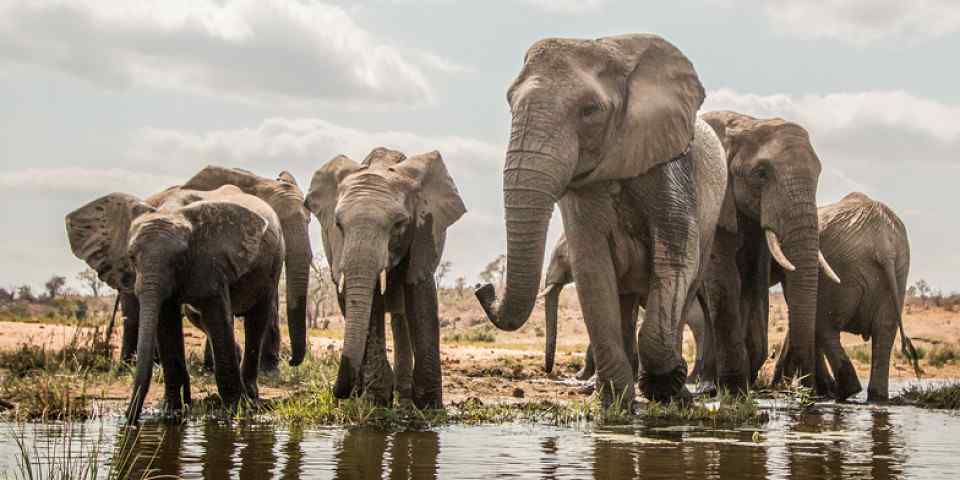- You are here:
- Home
- Countries & Parks
- South Africa Parks
- Mapungubwe National Park
- Reviews
- Expert Reviews
Expert Reviews – Mapungubwe NP

Lizzie is a reputed guidebook writer and author of the Footprint guides to South Africa, Namibia, Kenya, Tanzania, Uganda and Zimbabwe.
5 people found this review helpful.
An ancient landscape offering a combination of cultural significance and rewarding game-viewing
A World Heritage Site and best known for its archaeological evidence of one of Africa’s earliest Iron Age civilisations, few people are aware of Mapungubwe’s value as a safari destination. It resembles a giant's land with huge boulders, massive baobab trees, and the impressive Mapungubwe Mountain with its impregnable cliffs. While most of the large game species are present, its proximity to Botswana and Zimbabwe means that numbers do fluctuate, but permanent pools in the Limpopo offer refuge to crocodile and hippo, there are viable populations of lion, leopard, elephant, cheetah and spotted hyena, and with more than 400 species including Pel’s fishing owl, ground hornbill and kori bustard, its regarded as a birding hotspot. As a fairly new park facilities are excellent – especially the treetop boardwalk at the confluence of the Limpopo and Shashe rivers; a peaceful vantage-point to watch elephant, impala, baboon, and plenty of bee-eaters and kingfishers.

Harriet is a zoologist with more than 20 years’ experience. She has the privilege of working with the world’s top wildlife photographers and photo-guides.
4 people found this review helpful.
A cultural treasure.
Mapungubwe National Park is a designated UNESCO World Heritage Site because of the cultural significance of Mapungubwe Hill. In the 1930’s, artefacts found here proved that Mapungubwe was at the centre of southern Africa’s first formal, urban society – centuries before white man’s arrival. I was lucky enough to be guided by Cedric Sethlako, previously voted SANParks Guide of the Year, and a charismatic and gifted story teller. A guided tour with Cedric is in my Top Ten Experiences in South Africa.
Mapungubwe is a little visited national park, but scenically very beautiful, on the borders of Botswana and Zimbabwe. It has stunning, rocky, open landscapes, dotted with giant baobab trees and elephants. There is an elevated canopy walk through the trees and a spectacular viewpoint at the confluence of the Limpopo and Shashe rivers. However, you are unlikely to see any predators and visitors choose Mapungubwe because of its cultural and scenic treasures.

Lucy is travel writer for a range of publications, including Lonely Planet's guides to Africa, Southern Africa and South Africa.
2 people found this review helpful.
A viewpoint to three nations
Driving through the scorched terrain of this park, which sits on South Africa's border with Zimbabwe and Botswana, I couldn't help wondering if there was actually any life to be found. Even the trees seemed lifeless and we saw little more than the occasional bug or butterfly as we explored the hilly park. We had chosen the worst time of day – noon – at a particularly hot time of year and were going to give up and come back another day when we found the tree top elephant walk. As we wandered along the elevated platforms, looking out at the Limpopo and Shashe rivers that mark the meeting point of the three countries, we heard a rustling below. The next half-hour was spent mere metres away from an elephant foraging right beneath us. One of South Africa's less visited national parks, Mapungubwe has gems for those willing to look. The park is also an important cultural site, with a museum housing archeological finds.

James is a travel writer and author of many Lonely Planet guides, including senior author of the guide to South Africa, Lesotho and Swaziland.
2 people found this review helpful.
Bush, baobabs and cultural significance
Getting to Mapungubwe is an experience in itself: driving along the Zimbabwe border on the empty Rte 572, you encounter shimmering mirages, troops of baboons and surreal baobab trees. The park is an extraordinary place, covering 28,000 hectares in the sweltering Limpopo River valley, with viewpoints providing panoramas of South Africa, Zimbabwe and Botswana. As well as the gnarly, rocky landscape and animals including leopards and elephants, Mapungubwe offers some fascinating cultural history.
A World Heritage Site, the park was once the heart of southern Africa's first indigenous kingdom. More than 9,000 people lived here around AD 1300, and archaeologists discovered a hilltop graveyard, containing treasures such as a rhino figurine wrapped in gold foil. Tours of the award-winning Interpretive Centre and the graveyard give a sense of Mapungubwe’s historical significance.

Alan is a travel writer and author of over 20 Lonely Planet guidebooks, including the guides to Southern Africa and Zambia & Malawi.
2 people found this review helpful.
Culture, wildlife, scenery....
I went to Mapungubwe in January and it was hot...seriously hot...and seriously worth it. The wildlife almost plays third fiddle to the park’s other novel attractions. A Unesco World Heritage Site, Mapungubwe’s cultural landscape reveals a sophisticated African society discovered through archaeological finds that include a gold-plated rhinoceros dating back to the 13th century. The interpretive centre traces this uniquely African story and is both a fascinating place of discovery (keep an eye out for the intricate beadwork) and one of the country’s most startling pieces of modern architecture... and the icy air-con blast as you walk in is very welcome.
And then there’s the landscape: rocky, arid, creased with age and roofed with big skies. A wonderful viewpoint is at the confluence of South Africa, Botswana and Zimbabwe, which can be accessed from four viewing decks set high on a bluff. Jaw-dropping views include the Limpopo and Shashe rivers and big, furry rock dassies in the emergency-sitting position.
I didn’t see that much wildlife but was delighted by the unusual mix I did spot including meercats (first time - the babies are soooo cute), blue duiker spying on our bungalow and lumbering eland.

Ariadne is a renowned African wildlife photographer whose work is featured in many well-known guidebooks and magazines.
1 person found this review helpful.
Mapungubwe, an archaeological site in 3 countries
The main attraction in this park with World Heritage status is Mapungubwe Hill, an Iron and Stone Age site. Morning and afternoon tours are conducted daily. I found the tour very informative and more than worthwhile. Aside from the archaeological significance this is also a place of great beauty. I love the rugged landscape, dotted with baobab trees and sandstone boulders. A highlight is the view site overlooking the confluence of the Limpopo and Shashe rivers, also the place where 3 countries meet.
There aren’t a lot of game-viewing roads in this small park, but there is a good chance of seeing elephants and some antelopes including klipspringer, which can often be seen in pairs standing on the rocks. Black eagles love this kind of habitat and are often seen flying in the sky.

Philip is an acclaimed travel writer and author of many guidebooks, including the Bradt guides to Uganda, Tanzania, Kenya and South Africa.
Lost city on the Limpopo
Inscribed as a UNESCO World Heritage Site in 2003, this relatively new national park is not primarily a wildlife destination, so it ranks quite poorly judged on those terms. Its centrepiece is Mapungubwe Hill, site of the medieval capital of a wealthy trade empire that supplied locally sourced gold, copper and ivory to the Swahili Coast of East Africa in the 13th-century peak, and whoch formed the precursor to the altogether more impressive stone ruins of Great Zimbabwe to the north. Guided tours of the archaeological site run every morning, but be warned that it is of greater academic interest than it is impactful to the casual visitors. The park lies on the tripartite border with Botswana and Zimbabwe, and protects a stunning landscape of baobab-studded granitic hills overlooking the sluggish Limpopo River. Aside from birds, which are plentiful, the most common wildlife is elephant, greater kudu and klipspringer, though lion and leopard are present.


 South Africa Parks
South Africa Parks
